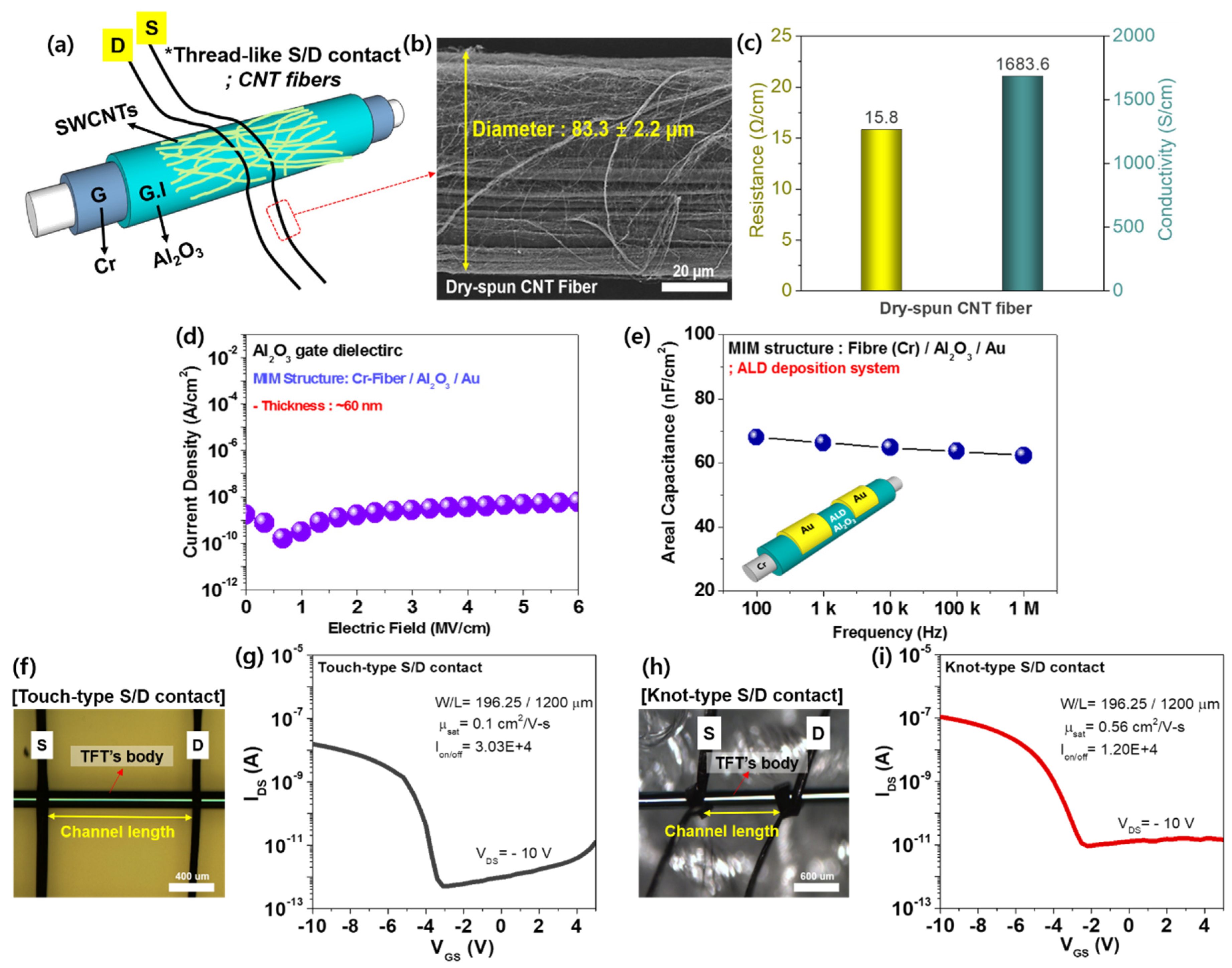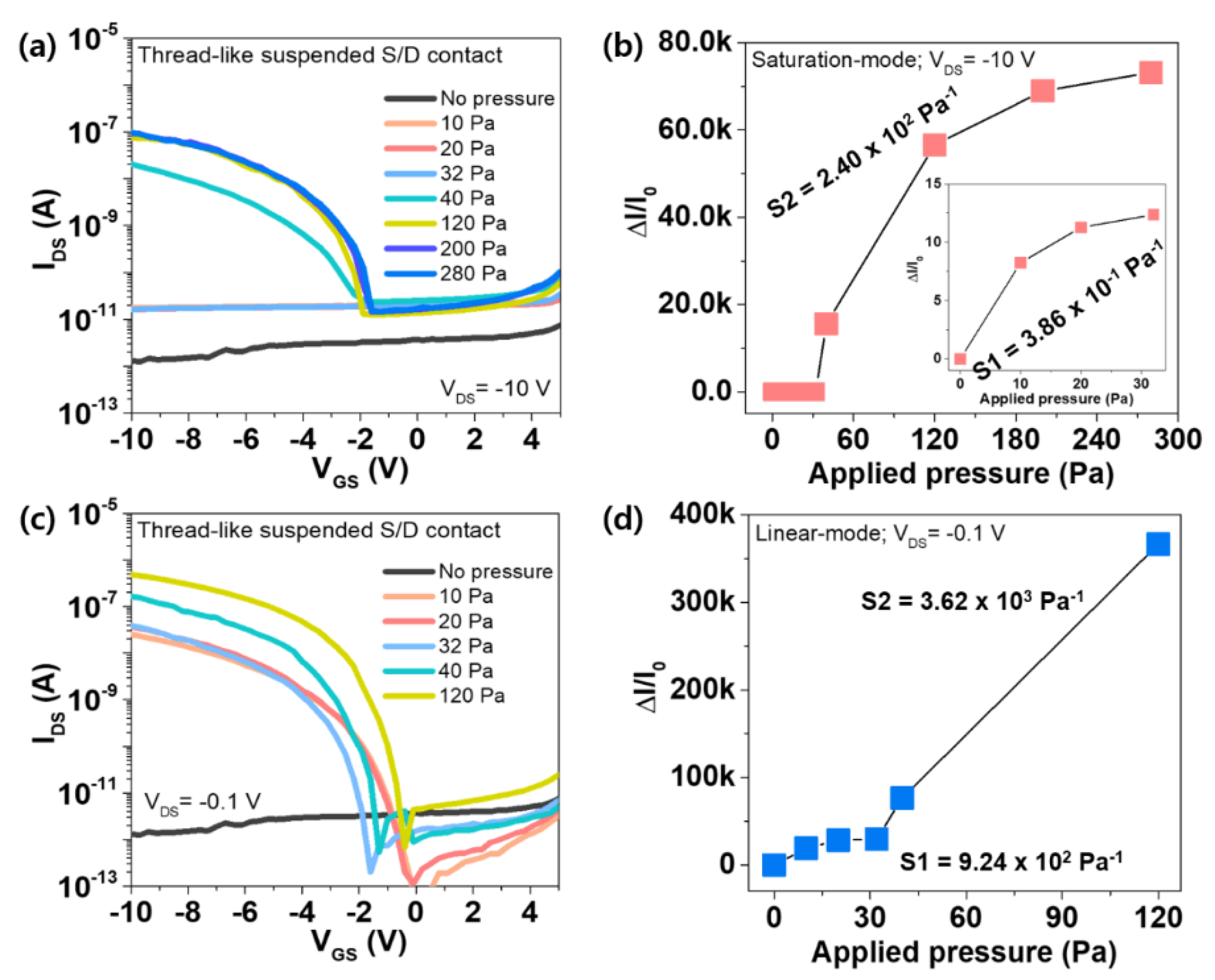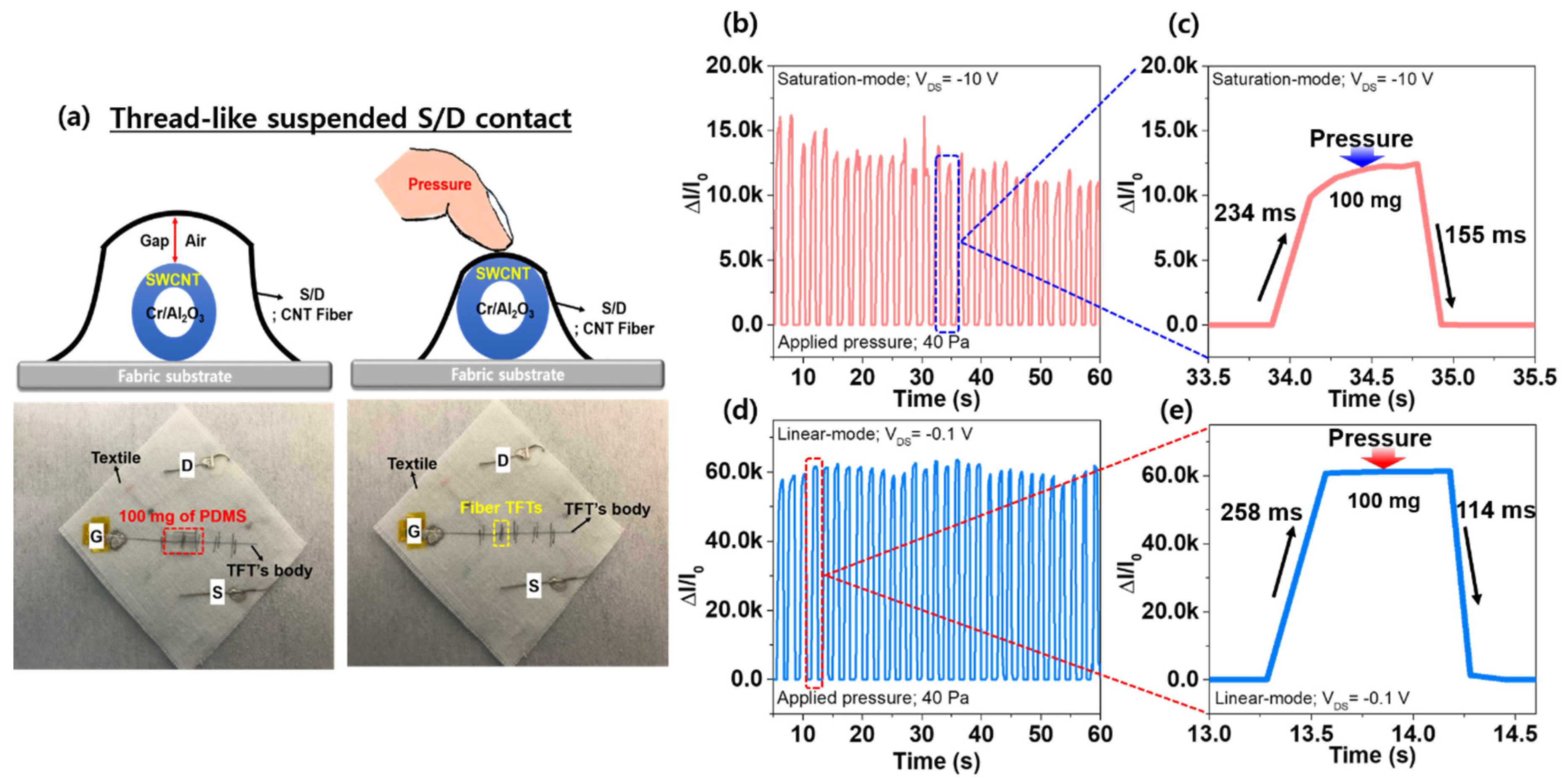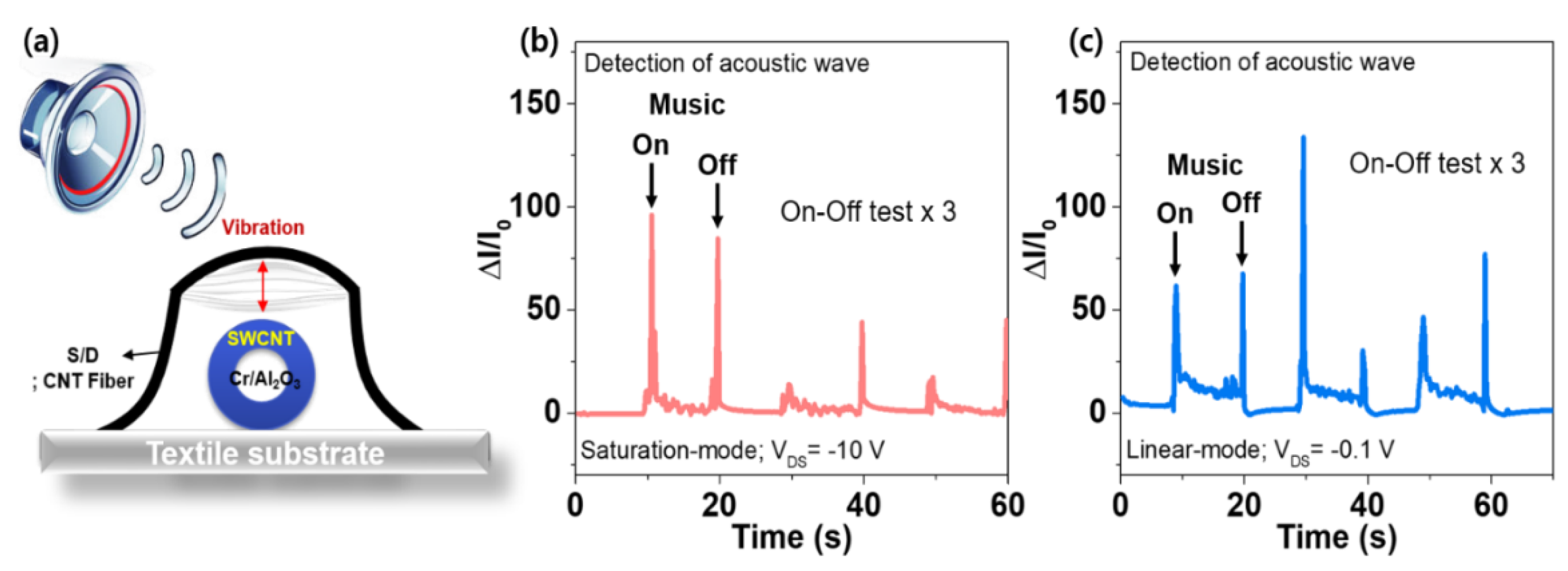Highly-Sensitive Textile Pressure Sensors Enabled by Suspended-Type All Carbon Nanotube Fiber Transistor Architecture
Abstract
1. Introduction
2. Materials and Methods
2.1. Preparation of Semiconducting Single-Walled Carbon Nanotubes (SWCNT) Solution
2.2. Film Deposition and Device Fabrication
2.3. Device Characterizations
3. Results and Discussions
4. Conclusions
Author Contributions
Funding
Conflicts of Interest
References
- Heo, J.S.; Eom, J.; Kim, Y.-H.; Park, S.K. Recent Progress of Textile-Based Wearable Electronics: A Comprehensive Review of Materials, Devices, and Applications. Small 2018, 14, 1703034. [Google Scholar] [CrossRef] [PubMed]
- Wang, X.; Liu, Z.; Zhang, T. Flexible sensing electronics for wearable/attachable health monitoring. Small 2017, 13, 1602790. [Google Scholar] [CrossRef] [PubMed]
- Stoppa, M.; Chiolerio, A. Wearable electronics and smart textiles: A critical review. Sensors 2014, 14, 11957–11992. [Google Scholar] [CrossRef] [PubMed]
- Jin, H.; Abu-Raya, Y.S.; Haick, H. Advanced materials for health monitoring with skin-based wearable devices. Adv. Healthc. Mater. 2017, 6, 1700024. [Google Scholar] [CrossRef]
- Trung, T.Q.; Lee, N.E. Flexible and stretchable physical sensor integrated platforms for wearable human-activity monitoringand personal healthcare. Adv. Mater. 2016, 28, 4338. [Google Scholar] [CrossRef]
- Binghao, W.; Facchetti, A. Mechanically flexible conductors for stretchable and wearable E-skin and E-textile devices. Adv. Mater. 2019, 12, 1901408. [Google Scholar]
- Shi, J.; Liu, S.; Zhang, L.; Yang, B.; Shu, L.; Yang, Y.; Ren, M.; Wang, Y.; Chen, J.; Chen, W.; et al. Smart Textile-Integrated Microelectronic Systems for Wearable Applications. Adv. Mater. 2019, 32, 1901958. [Google Scholar] [CrossRef]
- Yan, W.; Dong, C.; Xiang, Y.; Jiang, S.; Andreas, L.; Loke, G.; Xu, W.; Hou, C.; Zhou, S.; Chen, M.; et al. Thermally drawn advanced functional fibers: New frontier of flexible electronics. Mater. Today 2020, 35, 168–194. [Google Scholar] [CrossRef]
- Tao, X. Study of fiber-based wearable energy systems. Acc. Chem. Res. 2019, 52, 307–315. [Google Scholar] [CrossRef]
- Yang, B.; Wang, X.; Xiong, Y.; Liu, S.; Liu, S.R.; Guo, X.; Tao, X.M. Smart bionic morphing leg mannequin for pressure assessment of compression garment. Smart Mater. Struct. 2020, 29, 055041. [Google Scholar] [CrossRef]
- Yan, W.; Page, A.; Nguyen-Dang, T.; Qu, Y.; Sordo, F.; Wei, L.; Sorin, F. Advanced multimaterial electronic and optoelectronic fibers and textiles. Adv. Mater. 2019, 31, 1802348. [Google Scholar] [CrossRef] [PubMed]
- Loke, G.; Yan, W.; Khudiyev, T.; Noel, G.; Fink, Y. Recent progress and perspectives of thermally drawn multimaterial fiber electronics. Adv. Mater. 2020, 32, 1904911. [Google Scholar] [CrossRef] [PubMed]
- Yan, W.; Richard, I.; Kurtuldu, G.; James, N.D.; Schiavone, G.; Squair, J.W.; Nguyen-Dang, T.; Gupta, T.D.; Ou, Y.; Cao, J.D.; et al. Structured nanoscale metallic glass fibres with extreme aspect ratios. Nat. Nanotechnol. 2020, 15, 875–882. [Google Scholar] [CrossRef] [PubMed]
- Dong, K.; Peng, X.; Wang, Z.L. Fiber/Fabric-Based piezoelectric and triboelectric nanogenerators for flexible/stretchable and wearable electronics and artificial intelligence. Adv. Mater. 2020, 32, 1902549. [Google Scholar] [CrossRef]
- Min, S.D.; Yun, Y.; Shin, H. Simplified structural textile respiration sensor based on capacitive pressure sensing method. IEEE Sens. J. 2014, 14, 3245–3251. [Google Scholar]
- Pacelli, M.; Loriga, G.; Taccini, N.; Paradiso, R. Sensing fabrics for monitoring physiological and biomechanical variables: E-textile solutions. In Proceedings of the 3rd IEEE-EMBS International Summer School and Symposium on Medical Devices and Biosensors, Cambridge, MA, USA, 4–6 September 2006; pp. 1–4. [Google Scholar]
- Paradiso, R.; Loriga, G.; Taccini, N. A wearable health care system based on knitted integrated sensors. IEEE Trans. Inf. Technol. Biomed. 2005, 9, 337–344. [Google Scholar] [CrossRef]
- Lee, J.; Heo, J.; Kim, Y.; Eom, J.; Jung, H.; Kim, J.; Kim, I.; Park, H.; Mo, H.; Kim, Y.; et al. A behavior-learned cross-reactive sensor matrix for intelligent skin perception. Adv. Mater. 2020, 32, 2000969. [Google Scholar] [CrossRef]
- Zeng, W.; Shu, L.; Li, Q.; Chen, S.; Wang, F.; Tao, X.-M. Fiber-based wearable electronics: A review of materials, fabrication, devices, and applications. Adv. Mater. 2014, 26, 5310. [Google Scholar] [CrossRef]
- Cherenack, K.; Zysset, C.; Kinkeldei, T.; Münzenrieder, N.; Tröster, G. Woven electronic fibers with sensing and display functions for smart textiles. Adv. Mater. 2010, 22, 5178. [Google Scholar] [CrossRef]
- Kim, K.N.; Chun, J.; Kim, J.W.; Lee, K.Y.; Park, J.; Kim, S.; Wang, Z.L.; Baik, J.M. Highly stretchable 2D fabrics for wearable triboelectric nanogenerator under harsh environments. ACS Nano 2015, 9, 6394. [Google Scholar] [CrossRef]
- Zeng, W.; Tao, X.-M.; Chen, S.; Shang, S.; Chan, H.L.W.; Choy, S.H. Highly durable all-fiber nanogenerator for mechanical energy harvesting. Energy Environ. Sci. 2013, 6, 2631. [Google Scholar] [CrossRef]
- Liu, L.; Pan, J.; Chen, P.; Zhang, J.; Yu, X.; Ding, X.; Wang, B.; Sun, X.; Peng, H. A triboelectric textile templated by a three-dimensionally penetrated fabric. J. Mater. Chem. A 2016, 4, 6077. [Google Scholar] [CrossRef]
- Li, Y.; Zhang, Z.; Li, X.; Zhang, J.; Lou, H.; Shi, X.; Cheng, X.; Peng, H. A smart, stretchable resistive heater textile. J. Mater. Chem. C 2017, 5, 41. [Google Scholar] [CrossRef]
- Jin, H.; Matsuhisa, N.; Lee, S.; Abbas, M.; Yokota, T.; Someya, T. Enhancing the performance of stretchable conductors for E-textiles by controlled ink permeation. Adv. Mater. 2017, 29, 1605848. [Google Scholar] [CrossRef] [PubMed]
- Park, C.J.; Heo, J.S.; Kim, K.-T.; Yi, G.; Kang, J.; Park, J.S.; Kim, Y.-H.; Park, S.K. 1-Dimensional fiber-based field-effect transistors made by low-temperature photochemically activated sol-gel metal-oxide materials for electronic textiles. RSC Adv. 2016, 6, 18596. [Google Scholar] [CrossRef]
- Pu, X.; Li, L.; Liu, M.; Jiang, C.; Du, C.; Zhao, Z.; Hu, W.; Wang, Z.L. Wearable self-charging power textile based on flexible yarn supercapacitors and fabric nanogenerators. Adv. Mater. 2015, 28, 98. [Google Scholar] [CrossRef] [PubMed]
- Yu, X.; Pan, J.; Deng, J.; Zhou, J.; Sun, X.; Peng, H. A novel photoelectric conversion yarn by integrating photomechanical actuation and the electrostatic effect. Adv. Mater. 2016, 28, 10744. [Google Scholar] [CrossRef]
- Li, Y.; Huang, P.; Zhu, W.; Fu, S.; Hu, N.; Liao, K. Flexible wire-shaped strain sensor from cotton thread for human health and motion detection. Sci. Rep. 2017, 7, 45013. [Google Scholar] [CrossRef]
- Guo, J.; Liu, X.; Jiang, N.; Yetisen, A.K.; Yuk, H.; Yang, C.; Khademhosseini, A.; Zhao, X.; Yun, S.-H. Highly stretchable, strain sensing hydrogel optical fibers. Adv. Mater. 2016, 28, 10244. [Google Scholar] [CrossRef]
- Kim, Y.-H.; Heo, J.-S.; Kim, T.-H.; Park, S.; Yoon, M.-H.; Kim, J.; Oh, M.S.; Yi, G.-R.; Noh, Y.-Y.; Park, S.K. Flexible metal-oxide devices made by room-temperature photochemical activation of sol-gel films. Nature 2012, 489, 128–132. [Google Scholar] [CrossRef]
- Liu, M.; Pu, X.; Jiang, C.; Liu, T.; Huang, X.; Chen, L.; Du, C.; Sun, J.; Hu, W.; Wang, Z.L. Large-Area all-textile pressure sensors for monitoring human motion and physiological signals. Adv. Mater. 2017, 1703700. [Google Scholar] [CrossRef] [PubMed]
- Ge, J.; Sun, L.; Zhang, F.-R.; Zhang, Y.; Shi, L.-A.; Zhao, H.-Y.; Zhu, H.-W.; Jiang, H.-L.; Yu, S.-H. A stretchable electronic fabric artificial skin with pressure-, lateral strain-, and flexion-sensitive properties. Adv. Mater. 2016, 28, 722–728. [Google Scholar] [CrossRef] [PubMed]
- Nomura, K.; Ohta, H.; Takagi, A.; Kamiya, T.; Hirano, M.; Hosono, H. Room-temperature fabrication of transparent flexible thin-film transistors using amorphous oxide semiconductors. Nature 2004, 432, 488. [Google Scholar] [CrossRef] [PubMed]
- Liu, J.; Buchholz, D.B.; Chang, R.P.H.; Facchetti, A.; Marks, T.J. High-Performance flexible transparent thin-film transistors using a hybrid gate dielectric and an amorphous zinc indium tin oxide channel. Adv. Mater. 2010, 22, 2333. [Google Scholar] [CrossRef] [PubMed]
- Lee, J.; Kwon, H.; Seo, J.; Shin, S.; Koo, J.H.; Pang, C.; Son, S.; Kim, J.H.; Jang, Y.H.; Kim, D.E.; et al. Conductive fiber-based ultrasensitive textile pressure sensor for wearable electronics. Adv. Mater. 2015, 27, 2433–2439. [Google Scholar] [CrossRef]
- Honda, W.; Harada, S.; Arie, T.; Akita, S.; Takei, K. Wearable, human-interactive, health-monitoring, wireless devices fabricated by macroscale printing techniques. Adv. Func. Mater. 2014, 24, 3299. [Google Scholar] [CrossRef]
- Ji, S.; Jang, J.; Hwang, J.C.; Lee, Y.; Lee, J.-H.; Park, J.-U. Amorphous oxide semiconductor transistors with air dielectrics for transparent and wearable pressure sensor arrays. Adv. Mater. Technol. 2020, 5, 1900928. [Google Scholar] [CrossRef]
- Zang, Y.; Zhang, F.; Huang, D.; Gao, X.; Di, C.-A.; Zhu, D. Flexible suspended gate organic thin-film transistors for ultra-sensitive pressure detection. Nat. Commun. 2014, 6, 6269. [Google Scholar] [CrossRef]
- Shin, S.-H.; Ji, S.; Choi, S.; Pyo, K.-H.; An, B.W.; Park, J.; Kim, J.; Kim, J.-Y.; Lee, K.-S.; Kwon, S.-Y.; et al. Integrated arrays of air-dielectric graphene transistors as transparent active-matrix pressure sensors for wide pressure ranges. Nat. Commun. 2017, 8, 14950. [Google Scholar] [CrossRef]
- Lipomi, D.J.; Vosgueritchian, M.; Tee, B.C.; Hellstrom, S.L.; Lee, J.A.; Fox, C.H.; Bao, Z. Skin-Like pressure and strain sensors based on transparent elastic films of carbon nanotubes. Nat. Nanotechnol. 2011, 6, 788–792. [Google Scholar] [CrossRef]
- Yamada, T.; Hayamizu, Y.; Yamamoto, Y.; Yomogida, Y.; Izadi-Najafabadi, A.; Futaba, D.N.; Hata, K. A stretchable carbon nanotube strain sensor for human-motion detection. Nat. Nanotechnol. 2011, 6, 296–301. [Google Scholar] [CrossRef] [PubMed]
- Schwartz, G.; Tee, B.C.K.; Mei, J.; Appleton, A.L.; Kim, D.H.; Wang, H.; Bao, Z. Flexible polymer transistors with high pressure sensitivity for application in electronic skin and health monitoring. Nat. Commun. 2013, 4, 1859. [Google Scholar] [CrossRef] [PubMed]
- Pei, K.; Chen, M.; Zhou, Z.; Li, H.; Chan, P.K.L. Overestimation of carrier mobility in organic thin film transistors due to unaccounted fringe currents. ACS Appl. Electron. Mater. 2019, 1, 379–388. [Google Scholar] [CrossRef]
- Lee, J.; Lim, K.-H.; Kim, Y.S. Effects of unusual gate current on the electrical properties of oxide tin-film transistors. Sci. Rep. 2018, 8, 13905. [Google Scholar] [CrossRef]





| Material/Structure | Sensitivity | Sensing Range | Limit of Detection | Ref. |
|---|---|---|---|---|
| CNT-coated Fabric and VHB | 14.4 kPa−1 | 0–15 kPa | 2 Pa | [32] |
| Woven structure | ||||
| AgNW and C-PDMS coated fibers | 4.29 N−1 | 0–20 N | 0.03 N | [33] |
| Coaxial structure | ||||
| SBS polymer and Ag nanoparticle fibers | 0.21 kPa−1 | 0–10 kPa | 0.05 N | [36] |
| Perpendicular cross structure | ||||
| Air-dielectric IGZO FETs with G-PDMS | 1.1 × 10−3 kPa−1 | 200–5 MPa | 0.21 kPa | [38] |
| (Transistor-type) | ||||
| Organic TFTs with suspended gate | 192 kPa−1 | 100–5 kPa | 0.5 Pa | [39] |
| (Transistor-type) | ||||
| Graphene FETs with air-dielectric | 2.05 × 10−4 kPa−1 | 250–3 MPa | 5 Kpa | [40] |
| (Transistor-type) |
Publisher’s Note: MDPI stays neutral with regard to jurisdictional claims in published maps and institutional affiliations. |
© 2020 by the authors. Licensee MDPI, Basel, Switzerland. This article is an open access article distributed under the terms and conditions of the Creative Commons Attribution (CC BY) license (http://creativecommons.org/licenses/by/4.0/).
Share and Cite
Heo, J.S.; Lee, K.W.; Lee, J.H.; Shin, S.B.; Jo, J.W.; Kim, Y.H.; Kim, M.G.; Park, S.K. Highly-Sensitive Textile Pressure Sensors Enabled by Suspended-Type All Carbon Nanotube Fiber Transistor Architecture. Micromachines 2020, 11, 1103. https://doi.org/10.3390/mi11121103
Heo JS, Lee KW, Lee JH, Shin SB, Jo JW, Kim YH, Kim MG, Park SK. Highly-Sensitive Textile Pressure Sensors Enabled by Suspended-Type All Carbon Nanotube Fiber Transistor Architecture. Micromachines. 2020; 11(12):1103. https://doi.org/10.3390/mi11121103
Chicago/Turabian StyleHeo, Jae Sang, Keon Woo Lee, Jun Ho Lee, Seung Beom Shin, Jeong Wan Jo, Yong Hoon Kim, Myung Gil Kim, and Sung Kyu Park. 2020. "Highly-Sensitive Textile Pressure Sensors Enabled by Suspended-Type All Carbon Nanotube Fiber Transistor Architecture" Micromachines 11, no. 12: 1103. https://doi.org/10.3390/mi11121103
APA StyleHeo, J. S., Lee, K. W., Lee, J. H., Shin, S. B., Jo, J. W., Kim, Y. H., Kim, M. G., & Park, S. K. (2020). Highly-Sensitive Textile Pressure Sensors Enabled by Suspended-Type All Carbon Nanotube Fiber Transistor Architecture. Micromachines, 11(12), 1103. https://doi.org/10.3390/mi11121103






